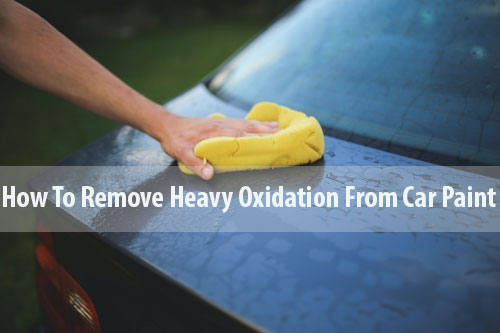
Any physical object is prone to decay over time, and one of the processes of decay is oxidation. If you ever noticed your silver jewelry losing its shine and glitter reducing to a dull replica of what it was before, it was due to oxidation.
Oxidation usually occurs due to the exposure of metal to moisture. The same process could happen to your car as well, making it dull and prone to rust on its metallic body.
However, there are levels of how your car paint can oxidize over time, and it’s essential to understand that before ever attempting to recover the oxidized paint.
So, let’s learn how to remove heavy oxidation from car paint and the levels of oxidation.
Table of Contents
Levels Of Oxidation On Car Paints
Here are the levels of oxidation on car paints:
- Level 1: This is the first stage of oxidation. Usually visible after a month of the process, this gives the surface a dull look compared to its natural allure.
- Level 2: The second stage of oxidation, and usually as it progresses after the first stage, the paint begins to fade.
- Level 3: At this point in the process, we move on to heavy oxidation. The third stage causes the surface to have a dull, chalky surface continuing the decay.
- Level 4: Final and fourth stage of oxidation, and from henceforth it is irreversible damage and can only be cured through a whole new coat of paint.
The last step is apparent coat failure, and it can cause the pain to completely dissolve, leaving entire patches which are visible signs of irreversible oxidation.
Rusting Vs Oxidation
A lot of people make the mistake of thinking oxidation and rusting are the same, and it can cause severe misconceptions in regards to how to treat your car.
Before rusting, there’s oxidation, as the oxygen molecules dissolve the single-stage paint job. The science behind this is that oxygen molecules make any other molecules/atoms near them give up their electrons. This can cause the said molecules to disintegrate over time and that is what happens in oxidation.
The first stage of oxidation can only affect the uppermost layer of the paint job and can give a dull look. However, as time progresses this can have severe consequences.
How To Restore Oxidation
In order to have a proper restoration of oxidation, there are a few steps to look out for. Starting with:
1. Cleaning
The first step is to clean your car before you restore it and try to work on the damages from the oxidation. Find a cool shaded place, preferably with a temperature of 20 to 23-degree Celsius.
This step is required as the heat can cause foaming when you start cleaning the oxidized surface. The cleaning is vital to make sure dirt and dust are not accumulating, and there are no water spots on the car.
2. Polishing
When moving on to the next step, which is polishing your car with a compound to remove the oxidation from your car, it is essential to understand the types of compounds.
Mainly there are two types of compounds when working with oxidation; Polishing Compound and Rubbing Compound.
-
Polishing Compound
In cases of light to moderate oxidation, you can opt for a polishing compound. As it’s usually used for lighter stages of oxidation, you can also use it by hand if you don’t have experience using a buffer, even if it means it will take longer.
Using a buffer without prior knowledge can lead to unintended swirls leaving your car looking like it had a terrible polishing job. In more severe cases, misusage of the buffer can lead to permanent damage to the vehicle.
-
Rubber Compounds
For oxidation which is in the later stages, you may want to opt for a compound that is heavier in terms of restoring. For instance, rubbing compounds are usually used for level 2 or 3 oxidation. For this compound, knowledge of handling buffer is essential.
The buffer can work on the damaged area with the exact amount of pressure that is required. Your hand cannot provide the consistent pressure that’s usually needed to not damage the paint underneath, and rubber compounds are generally not as forgiving as the polishing compound.
While polishing, the right techniques can make it or break it. The application of the compounds should be direct, precise, and they should be removed as soon as possible with a clean wet cloth. This action makes sure there is no formation of permanent swirls after the application.
Afterward, the wetness of the surfaced should dry off completely with a soft cloth to avoid watermarks. Following catering to the surfaces of the car, it is also essential to pay attention to the oxidized headlights and clean it with the necessary cleaner and polisher.
3. Waxing
The last step to removing oxidation is waxing. Waxing gives a layer of protection after the cleaning and polishing making it essentially resistant to further oxidation.
Obviously, this step is not once-in-a-lifetime but requires regular waxing every month or so to keep reinforcing the protective layer over and over again.
Prevention Is Better Than Treatment
Oxidation is the silent killer that can ruin the car’s surface before it turns to rust. It’s usually inconspicuous until it reaches a more damaging state. To prevent that, it’s much more important to actually prevent oxidation rather than focus on the removal of oxidation of your car or trailer paint.
First and foremost, regular waxing is incomparable in terms of a preventive method. It gives a protective layer to your car. The second job is to make sure your vehicle is kept in the shade, such as a garage or under protective cover. These simple steps can avoid the work of all the steps we’ve mentioned before.
